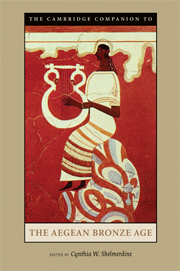Book contents
- Frontmatter
- 1 Background, Sources, and Methods
- 2 The Early Bronze Age in Greece
- 3 The Early Bronze Age in the Cyclades
- 4 Early Prepalatial Crete
- 5 Protopalatial Crete
- 6 The Material Culture of Neopalatial Crete
- 7 Minoan Culture: Religion, Burial Customs, and Administration
- 8 Minoan Crete and the Aegean Islands
- 9 Minoan Trade
- 10 Early Mycenaean Greece
- 11 Mycenaean Art and Architecture
- 12 Mycenaean States
- 13 Burial Customs and Religion
- 13A Death and the Mycenaeans
- 13B Mycenaean Religion
- 14 Mycenaean Greece, the Aegean and Beyond
- 15 Decline, Destruction, Aftermath
- Glossary
- Select Bibliography
- Index
- Plate section
13A - Death and the Mycenaeans
from 13 - Burial Customs and Religion
Published online by Cambridge University Press: 28 November 2010
- Frontmatter
- 1 Background, Sources, and Methods
- 2 The Early Bronze Age in Greece
- 3 The Early Bronze Age in the Cyclades
- 4 Early Prepalatial Crete
- 5 Protopalatial Crete
- 6 The Material Culture of Neopalatial Crete
- 7 Minoan Culture: Religion, Burial Customs, and Administration
- 8 Minoan Crete and the Aegean Islands
- 9 Minoan Trade
- 10 Early Mycenaean Greece
- 11 Mycenaean Art and Architecture
- 12 Mycenaean States
- 13 Burial Customs and Religion
- 13A Death and the Mycenaeans
- 13B Mycenaean Religion
- 14 Mycenaean Greece, the Aegean and Beyond
- 15 Decline, Destruction, Aftermath
- Glossary
- Select Bibliography
- Index
- Plate section
Summary
Introduction
From its very beginnings, Aegean archaeology has been haunted by graves: early travelers marveled at the Treasury of Atreus, nineteenth-century museum collections were enriched from rifled chamber tombs such as those on Rhodes, and Schliemann dazzled his contemporaries with reports of gold from the shaft graves at Mycenae (Ch. 11, pp. 258). In the twenty-first century CE, this emphasis can seem misplaced: our concern is how people lived during the Bronze Age, not how they were buried. How can the study of burials be justified? Quantity is one justification: whereas the number of excavated settlements can be counted in tens, the number of cemeteries is in hundreds, tombs in thousands, and burials in tens of thousands. Moreover, whereas the more extensively excavated settlements are important palaces, the cemeteries give us a better feel for the smaller provincial centers, towns, and villages where most Mycenaeans lived. (Intensive survey has now also helped rectify that imbalance; Chs. 1, pp. 8-10; 12, p. 308). Furthermore, although funeral rituals are not everyday occurrences to tell us how people lived their everyday lives, archaeologists hope that the remains from the grave can inform us about important themes: social structure; status and wealth; the sense of community; the presentation of peoples' identities as male, female, or child or as official, craftsman, villager, or slave; the relation of individuals to their forebears. Certainly such hopes may not always be fully realized. The way an individual is portrayed in ceremonies such as funerals can be manipulated by the living to misrepresent their own status and that of the deceased.
- Type
- Chapter
- Information
- The Cambridge Companion to the Aegean Bronze Age , pp. 327 - 341Publisher: Cambridge University PressPrint publication year: 2008
- 6
- Cited by

